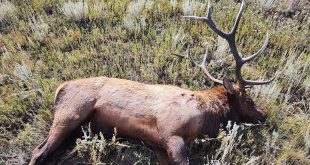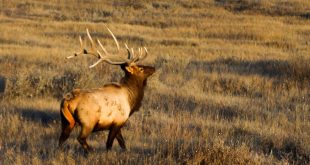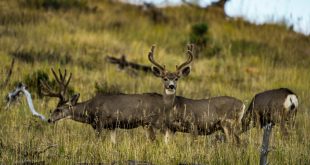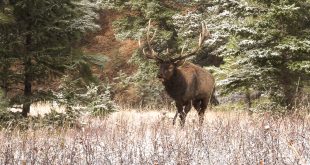
When it comes to hunting elk, the classic scenario you see on TV is calling a big bull into 20 yards, nostrils flaring and spit flying, all to make an easy shot. Any seasoned elk hunter knows it rarely happens this way, especially on highly pressured elk on public land. Calling in a big bull is harder now than ever on public land, so the odds are stacked against you. And a lot of times those smart old herd bulls are rarely in the mood to fight off a bull and instead just push their cows away and leave. Heck, many big old bulls won’t even bugle! So what do you do? Obviously, there are a lot of different paths you could go down here. Sitting wallows might work, or maybe a well-used trail. Some guys set up tree stands over wallows, which can be effective. Or maybe you’d rather call elk and don’t mind covering a ton of country to find a bull that wants to play. All are effective methods and everyone has their own preference. My style changes based on the area and state I’m hunting, but I mostly rely on spot-and-stalk tactics. I’ve found a lot of success over the years, and the areas and habitat I hunt dictate how and when to stalk elk. What follows are techniques I’ve learned over 15 years hunting elk; they’ve proven effective and they’ll work for you too.
The Wind
The most important component to putting together a successful stalk is the wind being in your favor. There’re just no ifs, ands, or buts about it. Of course, you often have thermals to consider in the mountains, but sometimes you don’t because of prevailing winds. In the summer and early fall, most of the weather we get here in the West comes from the southwest, west, or northwest. That said, I prefer to hunt west-facing slopes if possible, especially when I’m in the mountains, where the wind can be the most squirrely. Of course, changing weather patterns and game movement can nix that reasoning, but it’s something to keep in mind when you’re hunting that will give you the edge needed to seal the deal. I love hunting in a strong wind to cover my movement. I can count the number of times on two hands that I stalked in windy or rainy conditions and filled my tag, no matter what species I was hunting. I always consider good wind as a prerequisite to a successful stalk, acting to cover some if not all of my movement.
Stalking the “Thicks”
As you can imagine, stalking elk in thick brush and timber is challenging and not usually recommended. Most of the type of forest I’m talking about is found in northwest Montana and northern Idaho. Alder, devil’s club, huckleberry brush, mountain maple and moderate forest canopy make for a tangle that no sane man likes to walk through. Stalking through this stuff is just not realistic and will not increase your odds of success. In the very odd case that conditions are right, still hunting with a bow in the “thicks” can be productive. A scenario that comes to mind is if you can locate a bull that’s very vocal to move in on and have some favorable weather to work with; that could work. Strong/gusty winds or rain, or both, are two factors I look for, and prefer, that can give you the edge while stalking in close for a shot. Obviously, if the winds are swirly, you’d better sit tight and not try anything. Stalking near moving water as cover noise can also be your ace in the hole. Anything you have to work with to cover your noise is necessary to make a successful stalk in these conditions. Take the path of least resistance. Many times that means walking on game trails. If you’re in a zone that has solid elk numbers, there will be some freshly beat-down elk trails with soft dirt to walk in.
You need to move slowly. The less wind you have to cover your movement, the slower you need to go, like slug, slow. In actuality, most people cannot move this slowly.
A few months ago I was sneaking up on a bedded axis deer with little wind. I didn’t have much cover noise to work with, but time was on my side. It took two hours to belly crawl 60 yards and it paid off. This is what I’m talking about when it comes to moving slowly.
Stalking the Timber
Stalking in scattered timber varies, and conditions also must be ideal to be successful. Most of what you’ll be dealing with here are lodgepole pine flats, with dwarf huckleberry as ground cover or cool damp north faces with large Douglas fir trees and a little underbrush like snowberry. Once again, wind, rain, or snow helps to cover your movement. A decent rain or wet snow the night before might be all it takes for you to close the distance. Although rare, in late season bowhunting, a nice eight inches of powder snow could be perfect for stalking. But if the snow it too dry, it’s squeaky.
When I stalk this type of terrain, I’m referring to stalking bedding areas, which are usually on north faces. In more arid areas, north faces consist of old growth Douglas fir with little ground vegetation that provides good shade and comfortable conditions for a midday elk nap. These bedding areas also usually have plenty of trails and soft dirt to move quietly. Once you have a bull located, moving slowly is key. Take a few steps, stop, watch and glass; take a few more steps and glass some more.
Those smart old bulls will live and bed around jackpotted blowdown or steep, rocky areas and on benches with an impossible approach from behind them and a good view in front of them with the wind in their face. In cases like this I probably won’t attempt an approach unless I have a weather variable in my favor. I’ll sit it out and wait for him to move back to his feeding area in the afternoon. The best-case scenario is when I can get the wind in my favor and know what the elk are doing and I can intercept them to wherever they are traveling.
Stalking Open High Country
I prefer to hunt elk in open sage country or burned areas. Not only is it easier to keep track of the elk, but it gives you the ability to get on them easily when they aren’t talking. This tactic has really helped me over the years to be successful. Growing up hunting in thick country, I learned that bulls that are talking are pretty much the only bulls you get to play with, so you either have to keep traveling and looking for bulls that want to play or settle for whatever you can get to come to the call, which most of time in my experience are raghorns or smaller. Hunting open country gives you the freedom to be more selective and picky, getting opportunities at bulls that you otherwise wouldn’t find in thick country. Most times elk that reside in open country can live and feed anywhere, but will almost always bed on a north face or somewhere protected unless you’re dealing with winter temperatures. When I hunt open country, I encounter bulls out feeding on the slopes (usually west or outh facing) where the grass is best. As daylight hits, they work their way back to a Douglas fir patch on a north face for the day.
Some areas in Wyoming, Montana and Idaho that I hunt are completely open. Elk have started inhabiting these open grasslands, even to rut, and the closest tree is a few miles away. Usually these areas are still pretty rugged or high elevation, so it appears elk find the ruggedness and isolation to be suitable for year-round living. This can be a fun style of hunting and is my favorite. There seems to always be plenty of terrain to work with when stalking, which makes it fun and you never have to rely on the elk talking.
So there you have it. Keep a few of these things in mind when you’re hunting the terrain in your area. Identify the type of area you’re hunting and apply some of these tactics on your next stalk. Stick to the shadows and move extremely slow. You can beat their eyes and ears, but you can’t beat their noses; the wind is the most important consideration, but being slow and deliberate is key as well. I promise you, you can beat their eyes right out in the open in front of them if you move slowly enough. So get into your zone, focus on being slow and smooth, and you just might sneak up on the bull of your dreams.
If you use all these tactics correctly this is the type of hunt you can have!
 Eastmans' Official Blog | Mule Deer, Antelope, Elk Hunting and Bowhunting Magazine | Eastmans' Hunting Journals
Eastmans' Official Blog | Mule Deer, Antelope, Elk Hunting and Bowhunting Magazine | Eastmans' Hunting Journals





One comment
Pingback: Closing the Distance - Elk Stalking Tactics - Eastmans' Official Blog | Mule Deer, Antelope, Elk Hunting and Bowhunting Magazine - Florida News